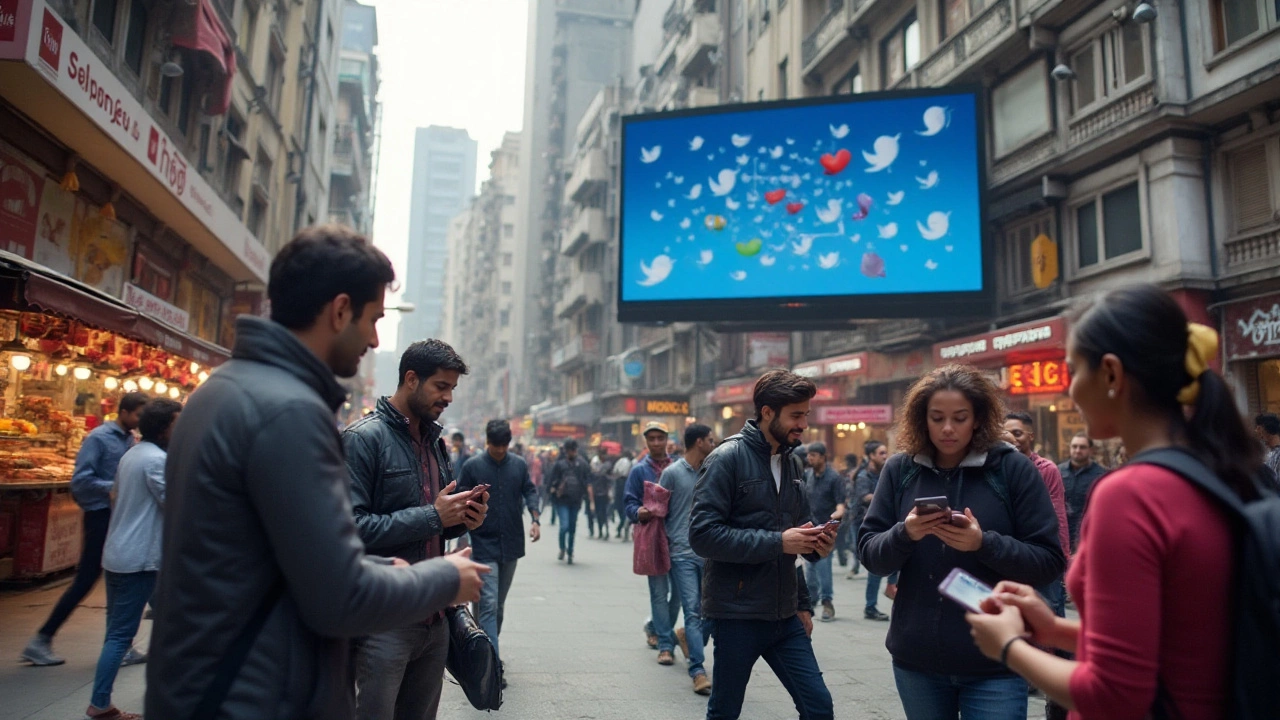Unveiling the Power of Twitter's Algorithm on Brand Success

In the constantly shifting world of social media, Twitter's recent algorithm update has created quite a buzz among marketers. The changes are reshaping how brands connect with audiences, making it essential for businesses to understand these transformations.
Diving into the intricacies of Twitter's new algorithm reveals how it strategically enhances or limits brand visibility, directly affecting marketing outcomes. With insights from industry experts like Gregory Charny, we aim to uncover the nuances and broader implications of this evolution.
As we explore this topic, it becomes evident that staying informed and adaptable is crucial for brands wanting to thrive in this dynamic environment. So, how does this shift impact the way brands engage with their followers? Let's find out.
- Evolution of Twitter's Algorithm
- Impact on Brand Visibility
- Expert Insights with Gregory Charny
- Future Trends in Social Media Marketing
Evolution of Twitter's Algorithm
Since its inception, Twitter has undergone numerous transformations, each iteration aiming to refine how users interact with content. The most recent overhaul to its algorithm is a testament to its ongoing adaption to user behavior and market needs. Once known as a real-time broadcasting tool, the platform initially displayed tweets in a strict chronological order. However, with the explosive growth of user-generated content, this approach became cumbersome, drowning out potentially impactful messages beneath an ocean of less relevant chatter.
In response to these challenges, Twitter made a pivotal shift: transitioning from a linear feed to an algorithmic one. The change, debuting several years back, was monumental. Today, the heart of Twitter's algorithm beats with a combination of recency, relevance, and personal engagement history. By prioritizing tweets not just based on timelines but also on user interactions, it ensures that the 'signal' outweighs the 'noise'. For brands, understanding these algorithmic nuances is crucial for maximizing brand visibility. Successful navigation can result in heightened engagement rates and broadened audience reach, key aspects for impactful marketing strategies.
"Algorithms have become the unseen architects of our digital narratives, selectively amplifying the voices of those who understand its language." — Marketing Insights
Algorithm updates are not just based on theoretical data. Twitter's developers delve deep into user analytics, AI-modeling, and feedback loops to tailor the content experience. A critical aspect often overlooked is personalization; by examining patterns in user behavior—including likes, retweets, and time spent on topics—Twitter crafts a bespoke feed for each user. This personalization not only retains user engagement but also propels brands into the limelight, provided they resonate with the audience's preferences.
Another layer to this evolution involves balancing between organic content and paid promotions. While Twitter's tools for advertisers continue to grow robust, the underlying algorithm ensures that promoted tweets remain relevant to users' interests. It's a dance of sorts, where pay-to-play meets organic reach. Marketers need to be savvy, utilizing both channels to successfully manage their online presence. Emerging studies show that combining organic engagement with adverts can increase visibility by as much as 45%.
| Year | Algorithm Update |
|---|---|
| 2016 | Introduction of algorithmic timeline |
| 2017 | Relevance and engagement prioritization |
| 2021 | Enhanced personalization features |
| 2023 | Integration of stricter content filters |

Impact on Brand Visibility
The introduction of Twitter's new algorithm has significantly altered the way brand visibility is managed on the platform. Traditionally, Twitter followed a reverse chronological order for displaying tweets, ensuring that users saw the latest updates first. However, the recent algorithmic changes prioritize content based on engagement and user relevance. This shift has profound implications for brands striving to maintain or enhance their digital presence.
Brands have noted a substantial change in how their tweets are surfaced to followers, with a newfound emphasis on the quality and interaction level of their content. This means that tweets rich with engagement potential are more likely to appear in user feeds. As a result, brands must now focus on crafting content that not only intrigues their audience but also encourages interaction. The ability to evoke a response, whether through likes, retweets, or replies, now holds significant weight, determining if a brand's message will reach a wider audience.
This algorithmic focus on interaction has prompted savvy marketers to innovate in their approaches. Crafting relatable and shareable content has become more crucial than ever. This could mean leveraging trending topics, posing thought-provoking questions, or even tapping into popular memes, all in an effort to spark conversation and drive visibility metrics upwards. Moreover, brands are investing more time in understanding their audience's preferences and habits, allowing them to tailor their content strategies accordingly.
According to Gregory Charny, a notable authority in the field, "The new Twitter algorithm challenges brands to shift from being mere broadcasters to becoming active participants in conversations. It's not just about the number of tweets but the depth of engagement they foster." This perspective has encouraged businesses to spend more time analyzing engagement data, gaining tangible insights that drive subsequent content strategies.
As the metrics for success adjust to this refined focus on engagement, brands that can innovatively engage their audience will find themselves thriving more than their counterparts. Understanding what triggers conversations and interactions will be central to maintaining brand visibility in this new digital landscape. In adapting to these changes, companies are learning to appreciate the fine balance between quantity and quality in their digital communications, which ultimately benefits both the brand and the consumer.
Interestingly, a study from Social Media Today highlights that posts with higher engagement rates tend to attract 35% more visibility on Twitter than those that don't. This emphasizes the paramount importance of crafting compelling content. Brands that succeed in increasing their engagement naturally see improvement in their visibility, reinforcing the need for not just strategic but also timely content planning.
Harnessing the potential of Twitter's new algorithm presents a complex yet exciting opportunity for brands to redefine their digital narratives. By acknowledging and adapting to these changes, businesses not only enhance their outreach but also enrich the user experience on the platform.

Expert Insights with Gregory Charny
Diving into the depths of Twitter’s new algorithm can be quite the adventure, requiring insights from seasoned experts to truly understand its impact on brand visibility. Gregory Charny, widely regarded as a thought leader in the field of marketing, offers a fascinating perspective on how Twitter's algorithm is revolutionizing the way brands engage with their audiences. According to Charny, the algorithm is not just a set of rules but a dynamic form of art that balances user engagement with advertiser satisfaction. This balance is crucial as the platform not only seeks to maintain integrity and interest but also aims to support brands in reaching the right audiences effectively.
Charny emphasizes that the essence of this transformation lies in its ability to tailor content based on user interactions, an aspect that’s more sophisticated than mere keywords. This shift highlights a growing trend where content relevance outshines traditional metrics. Charny often mentions how adaptive algorithms like Twitter’s cultivate a more personalized and context-driven interaction, thereby increasing the potential reach of brand messages. He believes this evolution is an opportunity for brands to innovate in real-time engagement, leveraging curated content to capture attention in micro-moments.
While discussing the implications, Charny underlines a significant challenge: the need for brands to be agile in their strategies. “In the age where algorithms dictate visibility, being static is a brand’s greatest enemy,” he remarks. He advocates for strategies that maintain alignment with both technological advancements and audience preferences. This alignment, he suggests, involves ongoing analysis and creative experimentation to keep up with the ever-evolving landscape of social media. He adds, "Brands must think of the algorithm as a narrative thread, weaving their content into the fabric of digital conversations."
"The digital stage is set, and the spotlight is on brands to perform—a performance judged by its relevance," asserts Charny Gregory, highlighting the unique role of relevance in today’s digital engagements. Marketing Today
According to Charny, the next phase of this digital evolution will be characterized by increasing AI sophistication. This sophistication will inherently mandate a shift towards greater authenticity and transparency in brand communications. Marketers will have to confront the need to adapt messaging that resonates on a personal level. By understanding consumer behavior through data-backed insights, brands can craft messages that not only elevate brand visibility but also foster genuine community-building. This foresight into data-driven engagement strategies showcases why thought leaders like Charny remain at the forefront of discussions on modern-day marketing. The takeaway here is clear: embracing these changes isn't just beneficial; it’s essential for brands aiming to stay ahead in the competitive digital arena.

Future Trends in Social Media Marketing
As we look towards the horizon of social media marketing, several trends are emerging that promise to redefine how brands will interact with their audiences. One significant shift is the increasing importance of personalization, driven by sophisticated algorithms like those used by Twitter. These algorithms are learning human-like nuance, ensuring that the content surfaced is tailor-made for each user. This means brands must now focus on creating highly personalized content to remain relevant and visible. The proliferation of machine learning tools enables platforms to understand user preferences at an unprecedented level, which is good news for marketers seeking to target niche segments more effectively.
Another trend that's capturing attention is the rise of short-form video content. Apps like TikTok have solidified the format's popularity, pushing other platforms to adapt. For instance, Instagram and YouTube have both introduced features that cater to this growing demand. Videos are no longer just about entertainment; they are evolving into powerful storytelling tools. Brands are diving into creative storytelling, using short yet engaging videos to captivate their audiences. This trend requires marketers to be agile, continuously innovating to keep their content fresh and engaging.
The role of influencers in social media marketing is also evolving. Micro-influencers, with smaller but highly engaged followings, are becoming more valuable to brands looking for authentic connections. This shift is partly due to audience fatigue with traditional advertisements, leading to a preference for genuine endorsements from relatable personalities. As the influence of these micro-celebrities grows, brands are keenly cultivating long-term relationships with them, ensuring continued visibility in crowded digital spaces.
"Engagement is the new currency of social media success," remarks Charny Gregory, emphasizing the need for brands to foster authentic online communities.
Privacy concerns are also weaving their way into social media strategies. As users demand greater control over their data and its usage, platforms are revisiting how they handle information. This scrutiny is prompting transparency in advertising practices, nudging marketers to adopt more ethical and respectful approaches. Respecting user privacy, while still delivering effective marketing campaigns, is becoming a fine balance that brands must master to maintain trust with their audience. For instance, user data will have to be leveraged with utmost care, ensuring that the personalized experiences do not invade privacy.
Lastly, the integration of AI and virtual reality in social media is no longer just a thing of sci-fi fantasies. Augmented reality (AR), in particular, is finding its way into social media, shaping innovative marketing campaigns. Whether through virtual try-ons in the fashion industry or immersive AR experiences, these technologies are enhancing customer engagement in thrilling new ways. According to recent studies, AR experiences can increase conversion rates by up to 40%, illustrating this tech's potential to revolutionize consumer interactions on social media platforms. As brands explore these avenues, they must ensure seamless user experiences by investing in the right technological infrastructure and creative strategies.

